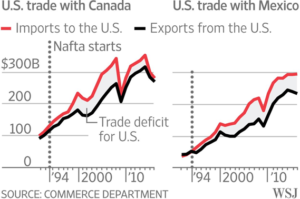A trade war has been averted with few casualties, at least for now. And, as a result, the United States is in a better position to negotiate with China and other countries.
That’s the most important takeaway from the new U.S.-Mexico-Canada Agreement (USMCA), which was negotiated and agreed upon just before the October 1 deadline for reaching an agreement.
The USMCA has some good and some bad in it, and is not radically different from the North American Free Trade Agreement (NAFTA), which it would replace, if approved by the U.S. Congress.
Most important, the U.S. economy can continue its current growth spurt with minimal damage from retaliatory tariffs. President Trump had previously threatened to pull out of NAFTA, which would have converted two major trading partners into trading foes, with serious consequences to the economies of all three nations.
The agreement is also a sign that the administration could revive U.S. participation in the Trans Pacific Partnership, a 12-country trading bloc that President Trump pulled out of as one of his first official acts.
While President Trump’s strong protectionist instincts may not have abated, they have been tempered by reason and pressure from members of Congress, advisers, business associates and lobbyists, who recognized the potential damage of an unwinnable trade war.
But what’s in USMCA and how will it affect you? And what does it mean for other potential trade deals?
What’s in the USMCA
It’s worth noting that the USMCA is not really a “free trade” agreement. But neither was NAFTA, regardless of its name. Free trade would require the elimination of all tariffs and quotas, so that markets would determine what’s traded and at what price.
Politics and partisanship make free trade untenable, but fair trade isn’t bad as a backup.
There is still plenty of protectionist sentiment in the new agreement, as it “introduces managed trade to autos, waters down the foreign rights of corporations and normalizes national security as a pretext for tariffs,” according to The Wall Street Journal.
The agreement offers some advantages over NAFTA, but The Journal adds, “Many of its improvements, such as on intellectual property and labor rights, were already in the 12-nation Trans-Pacific Partnership, from which President Donald Trump has withdrawn.”
Dispute settlement. One aspect of NAFTA that survived, in spite of President Trump’s initial objection, is the agreement’s dispute-settlement procedures, which are generally easier to use than the court system.
“The new text preserves the right to challenge antidumping and countervailing duties imposed by the neighbors,” according to The Wall Street Journal. “Panels to resolve state-to-state disputes also survived. This is vital to Canada to avoid America’s many protectionist business lobbies that use other U.S. laws to punish competition from imports such as lumber.”
Restricted use of Chapter 11. The use of Chapter 11, which protected U.S. investors from predatory government behavior, was eliminated for all industries in Canada and most industries in Mexico, except for some key industries such as energy and telecommunications.
“In Mexico only oil and gas, electricity, telecommunications, transportation and public works will have access to multilateral dispute panels,” The Wall Street Journal reported. “The rest will have to go through local courts unless their property is directly confiscated. This is worse than the status quo.”
Dairy products. U.S. farmers should benefit, as Canada agreed to eliminate its quota and pricing system on certain dairy products. Dairy exports from Canada could also be subject to a new tax imposed to discourage dairy farmers from pricing their exports below market prices.
Rules for materials, labor. The USMCA also imposes new rules regulating origin of materials and labor that could affect the auto industry.
Passenger vehicles and parts used in passenger vehicles will need to meet new content requirements to qualify for duty-free access to the U.S., which will “add costs and complexity to building cars on the continent, and make the final products less competitive world-wide,” according to The Journal.
In addition, car companies in Mexico will have to pay well above market wages on 40% of their output to qualify for duty-free treatment.
“Ford and GM have resigned themselves to this and may be able to finesse it,” according to The Journal, “but some people we respect think the net result will drive car production at the margin away from North America.”
However, The Washington Post noted that side letters to the agreement say Canada and Mexico can continue sending about the same number of vehicles and parts across the border free of charge, regardless of whether auto tariffs go into effect at a later date. Only parts above the quota would be subject to tariffs.
Steel and aluminum tariffs. The new tariffs of 25% on steel and 10% on aluminum imports will remain in place, despite the new agreement. However, the tariffs are still being discussed and may eventually be lifted.
Safety standards, labor rights. Before crossing the border, Mexican trucks will be required to meet higher safety standards. In addition, Mexican workers must be given more freedom to organize and form unions. While such provisions have nothing to do with trade, per se, they could potentially help win support from labor-friendly Democrats.
Intellectual property protection. The new agreement includes more stringent protection for patents and trademarks, and covers everything from biotechnology and financial services to domain names. In addition, U.S. drug companies will be able to sell patented pharmaceuticals in Canada for 10 years before generic competition is allowed, which is an increase from the current eight years of protection.
Genetically modified crops. The agreement bars banning or otherwise discriminating against genetically modified crops.
Once approved, the new agreement would remain in force for 16 years and be renewable for another 16 years, but it would also be subject to review after six years.
